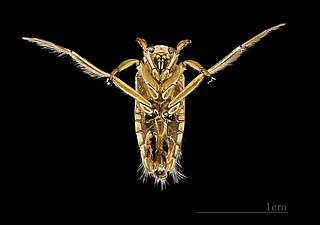
Corixidae is a family of aquatic insects in the order Hemiptera. They are found worldwide in virtually any freshwater habitat and a few species live in saline water. There are about 500 known species worldwide, in 55 genera, including the genus Sigara.

Nepomorpha is an infraorder of insects in the "true bug" order (Hemiptera). They belong to the "typical" bugs of the suborder Heteroptera. Due to their aquatic habits, these animals are known as true water bugs. They occur all over the world outside the polar regions, with about 2,000 species altogether. The Nepomorpha can be distinguished from related Heteroptera by their missing or vestigial ocelli. Also, as referred to by the obsolete name Cryptocerata, their antennae are reduced, with weak muscles, and usually carried tucked against the head.

Notonecta glauca, also known as the greater water-boatman or common backswimmer, is a species of aquatic insect in the family Notonectidae. This species is found in large parts of Europe, North Africa, and east through Asia to Siberia and China. In much of its range it is the most common backswimmer species. It is also the most widespread and abundant of the four British water-boatmen. Notonecta glauca are Hemiptera predators, that are approximately 13–16 mm in length. Females have a larger body size compared to males. These water insects swim and rest on their back and are found under the water surface. Notonecta glauca supports itself under the water surface by using their front legs and mid legs and the back end of its abdomen and rest them on the water surface; They are able to stay under the water surface by water tension, also known as the air-water interface. They use the hind legs as oars; these legs are fringed with hair and, when at rest, are extended laterally like a pair of sculls in a boat. Notonecta glauca will either wait for its prey to pass by or will swim and actively hunt its prey. When the weather is warm, usually in the late summer and autumn, they will fly between ponds. Notonecta glauca reproduce in the spring.

Brahmaea wallichii, also known as the owl moth, is a moth from the family Brahmaeidae, the Brahmin moths, and one of its largest species. It is found in the north of India, Nepal, Bhutan, Myanmar, China, Taiwan, and Japan. The owl moth is nocturnal. The wingspan is about 90–160 millimetres.

Notonecta, known as backswimmers or water-boatmen, is a genus of bugs in the family Notonectidae. Species in this genus include:

Odontopera insulata is a moth of the family Geometridae first described by Max Bastelberger in 1909. It is found in Taiwan.

Notonecta maculata is a backswimmer of the family Notonectidae, found in Europe, including the United Kingdom.

Notonecta undulata, also known by the common name grousewinged backswimmer, are from the family Notonectidae and the insect suborder Heteroptera. They are a type of hemipteran or true bug. These aquatic insects typically spend their time at the water's surface, using their abdomen and legs to cling to the underside of the surface tension. The Grousewinged backswimmer can be found in both lotic and lentic environments; however, they typically prefer small ponds and lakes where the water is slow-moving with less current. They swim upside down looking for prey. Once they stop swimming they float back up to the surface. These insects can be distinguished from water boatman or Corixidae by their segmented beak and front legs. Water boatman have highly modified front legs whereas backswimmers do not. Backswimmers are distributed across a broad range throughout North America. However, the species Notonecta undulata has only been documented and studied in southern Manitoba, Saskatchewan, Alberta and the western United States. N. undulata differs from other backswimmers by their antennae and size. They are approximately 10–12 mm long, and their antennae are 4 segmented.

Notonecta irrorata is a species of backswimmer native to North America first described by Philip Reese Uhler in 1879. Presence of N. irrorata in ponds is known to repel the oviposition of Culex mosquitoes.
Meridemis insulata is a species of moth of the family Tortricidae. It is found in India.

Comostola subtiliaria is a moth of the family Geometridae first described by Otto Vasilievich Bremer in 1864. It is a widespread species which is found in Korea and adjacent parts of Siberia, Japan, Borneo, Sumatra, India, South China, Taiwan, Borneo, Sumatra, and Sri Lanka.
Notonecta spinosa is a species of backswimmer in the family Notonectidae. It is found in North America.

Notonecta kirbyi, or Kirby's backswimmer, is a species of backswimmer in the family Notonectidae. It is found in North America.
Notonecta unifasciata is a species of backswimmer in the family Notonectidae. It is found in Central America, North America, and South America.

Notonecta lunata is a species of backswimmer in the family Notonectidae. It is found in North America.
Notonecta lobata is a species of backswimmer in the family Notonectidae. It is found in North America.
Notonecta borealis is a species of backswimmer in the family Notonectidae. It is found in North America.
Notonecta indica is a species of backswimmer in the family Notonectidae. It is found in the Caribbean Sea, Central America, North America, Oceania, and South America.

Notonecta uhleri is a species of backswimmer in the family Notonectidae. It is found in North America.











